Aeneas Wilder: Writings Iwate EarthQuake 2011 - OtsuchiTimes are Japanese standard time.
| 25th March | The trip to Otsuchi was primarily to get information about what was still required by the displaced refugees there. We also brought some basic things for the Nursery/kindergarden which had just re-opened in the Ando area |
Text of our journey to Otsuchi |
Passing traffic about 800metres up on the mountain road to Otsuchi |
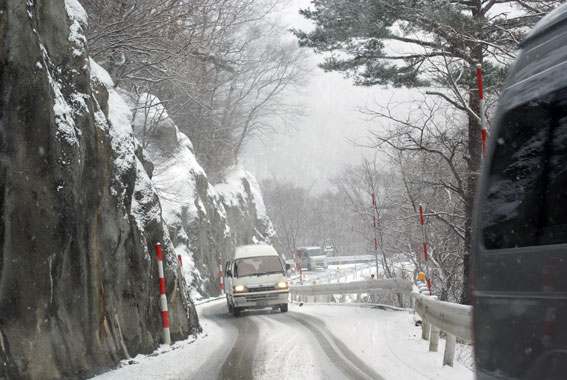 |
On the 25th March we went to Otsuchi town. We took the mountain pass on route 35 climbing to a height of about 850m, to avoid going through Kamaishi. There was sleet and snow and it was cold throughout the day even on the coast.As we came down into the flat area about 3kms back in the mountain road we begin to see debris from the tsunami. This quickly turned into a mass of mud, cars and broken house wood. |
Panorama of central Otsuchi A 17Mb version of this composite image can be downloaded here (download time about 5 minutes) |
 |
The tsunami surged up the river and inundated the distant residential areas, with extensive flooding. Otsuchi is scattered along the coast, broken by mountain protrusions, into several districts. |
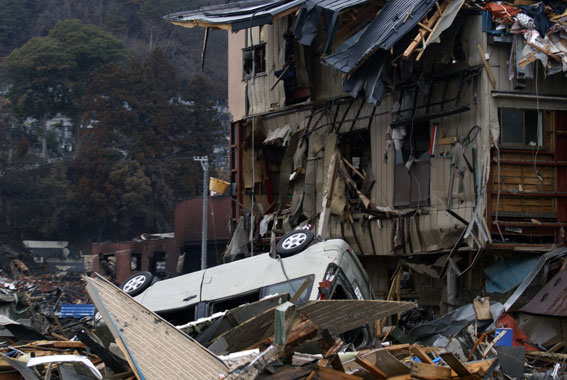 |
We reached the coast at the south side of Otsuchi. It was apparent that almost everything has been completely destroyed. Everything up to 10m - 20m above sea level will have been affected. The smell of decomposition mixed with sea air was readily apparent throughout the day. | |
Apartment blocks some 2kms inland from the sea |
|
We passed a council house estate, some of the few buildings still standing, as they were inland, on the breached side of Route 45 coastal road, even this far back, everything up to the third floor had been flooded. We passed through a tunnel going up the coast and came out onto central Otsuchi
|
Deatil showing sea walls in the harbour area |
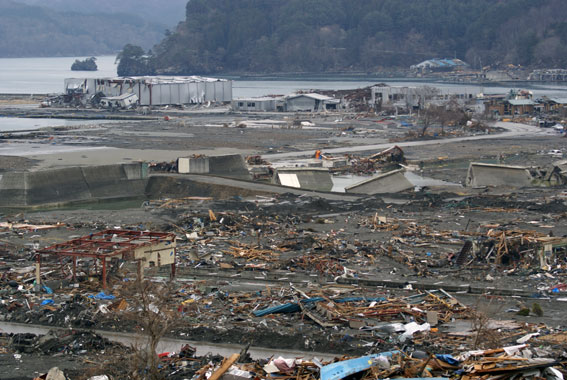 |
The whole of the town, other that high areas, has been destroyed. Large areas – entire districts, maybe even half of the town has been burnt. There were a lot of scorched areas. The sea walls had collapsed in many places. |
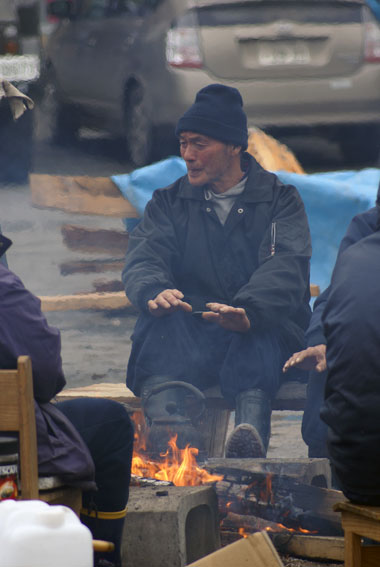 |
Naoko has some personal contacts in the slightly elevated Ando area. There was a heavy Self Defence Force presence in Otsuchi and it was impossible to find anywhere without asking for directions from workers there. We went first to the principal refugee centre in Ando as we wanted to know what was needed or not, (there are several of centres there holding around over 800 people). There were about five groups of men sitting round five or so fires, burning the scrap wood for warmth in the fresh air. |
|
Three cars in a burnt out area |
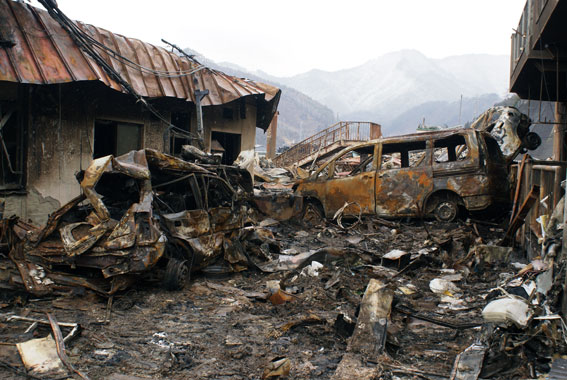 |
We then went to the Ostuchi Community centre, high above the city and a centre for all co-ordination efforts. Here we were able to get directions to the Tsutsumi kindergarden/nursery, the first such facility to reopen in Otsuchi since the tsunami. We met with the staff there and let them select the children’s items/cloths that they needed. We got more information about what was needed still. |
| Small refugee centre can be seen on the left. A 20Mb version of this composite image can be downloaded here (download time about 10 minutes |  |
I climbed a small hill, as we had stopped for a toilet break, and stood in a cemetery overlooking Otsuchi. Just below me was a refugee centre, next to a small gully, packed with the remains of that communities houses/homes. A dozen SDP were still trying to get into the buildings to find people or information about the occupiers. This was 14 days after the event! Mechanical diggers had yet to reach this small area, located on the landward side of a railway embankment.
|
Self Defence Force personel looking though the remains of a housing community, close to Ando |
 |
I could detected that people were reserved, indeed more closed than during our experience in Kamaishi and Ofunato. Later that evening, Naoko told me that the people in the nursery told her that there was a lot of suspicion about outsiders – that is people not from each immediate local community within Otsuchi, They said that they could not trust people that they did not know directly/personally, as there had been looting taking place after the Tsunami. Principally they mentioned that people were siphoning other people’s petrol and were also taking cash out of cash registers in crushed/dysfunctional shops |
A bridge near the waterfront |
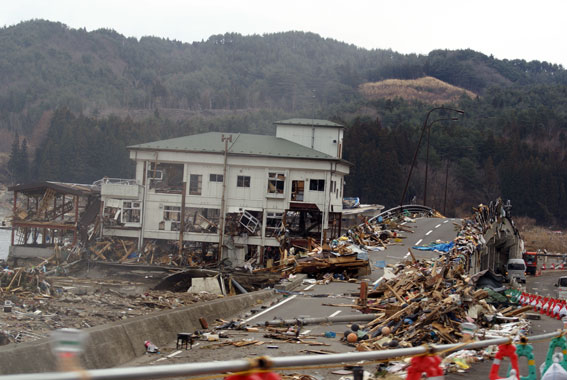 |
Basically “Japanese style” looting was going on – This is not the same as looting in other disaster areas of the world – but none the less, people were taking what did not belong to them. Even in Japan |
Self Defence Force personel can just be seen on a ridge20m above the sea. |
 |
The town was destroyed in such a totality that people were left with nothing. However, people in the outer lying areas, may have been flooded, but not completely cleaned out. They may have had a car that still worked, but there was no fuel. All the cash machines were out of order and so people did not have cash. Credit cards are also no good if all the shops are gone. However, what good is cash even if the shops are all destroyed! |
Central Otsuchi |
 |
The looting is understandable given the overall context. However, there is a great emphasis on goodness in Japan, and many people feel deep, profound, guilt if they cheat a system out of even 100 yen. Therefore if they were forced – through necessity – to take money or petrol they would thereafter carry an immense amount of guilt, further putting stress on their emotional wellbeing, and making them withdraw from any outside interest taken in their personal/private situation. This makes it difficult for open and honest communication about what people actually really need. Many people will feel that their privacy will have been invaded, and if they have guilt to hide this strengthens any barriers that may already exist
|
A small section of central Ostuchi |
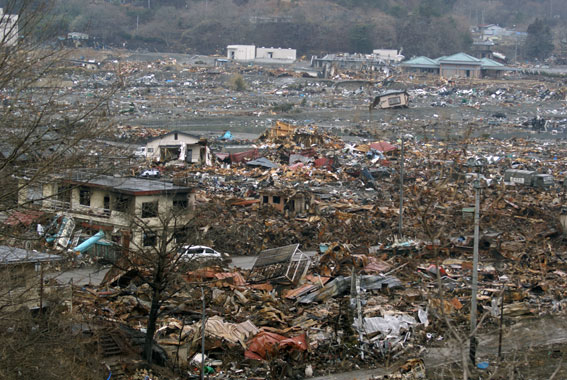 |
However, some people will have been simply looting – taking money and so on, purely for gain, exploiting the situation. Again, this is understandable, although again many people will not want to talk about this, as they would not want to show any community members in an unfavourable light. As of the 30th March, even in Hanamaki they have announced on the radio (in English even) warnings that looting may be taking place around the coastal areas.
|
Detail showing a burnt out shopping mall and residential housing, central Ostuchi |
 |
A few days after the quake, when TV was restored, Naoko told me that there were reports of fake calls for money to be donated. Basically a scam to extract money from people. I read in the Guardian on the 28th that this scam has now spread to the outside world. Now, basically anyone can do an email scam – from any country in the world (you may be familiar with your long lost uncle who died in a plane crash in Nigeria and left you millions of US dollars in his will) However, the phone scams for money donations that took place directly after the quake were done in Japan by people speaking Japanese.
|
The costal road to Akahama, a harbour suburb of Otsuchi |
 |
My intention is not to show Japan in an unfavourable light. I simply want to report what I have heard to let people know that the situation in Japan is not the simple disaster, relief/ rebuild that has been reported in the media. The half-life of this disaster seems to be about 8 days. The Fukushima problem, a bit longer. However, the bulldozed mud and rubble in Otsuchi (as well as many many other places) contains the remains of unaccounted for people and everybody on the coast knows this. You can smell it. |
Harbour side factory on the road to Akahama |
 |
I tried to ask a volunteer relief worker from Tokyo about the fundamental shift in peoples perspective that I believe will have/will have to have happened, but he could only give me a textbook answer as to how he hopes people will change. |
Central Otsuchi |
 |
|
Shopping centre(?) in Central Otsuchi |
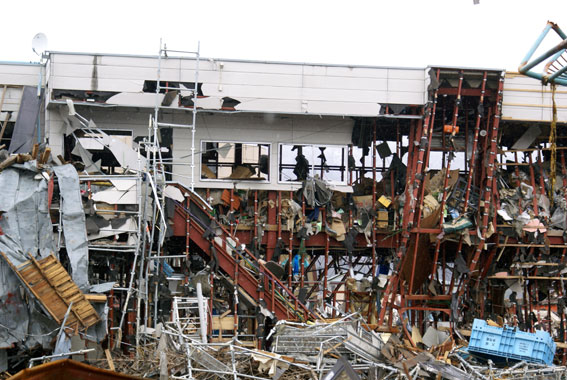 |
|
Trucks removing debris, central Otsuchi |
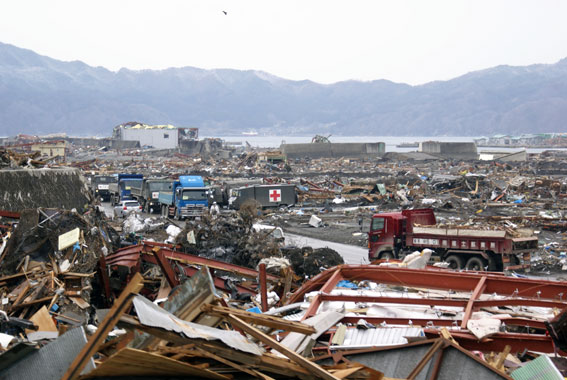 |
|
The block on the right is a toppled residenctial concrete building |
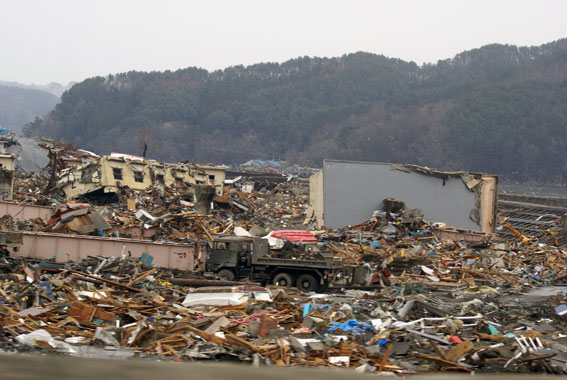 |
|
The road leading up to a refugee centre in Ando |
 |
|
Mobile phone charging point in the centre we visited in Ando |
 |
|
The road from Akahama round to Otsuchi |
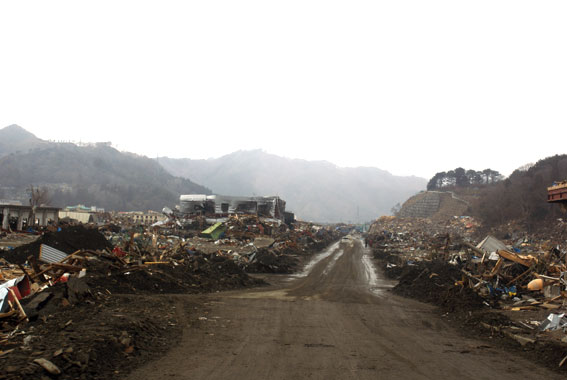 |
|
Boat in Akahama |
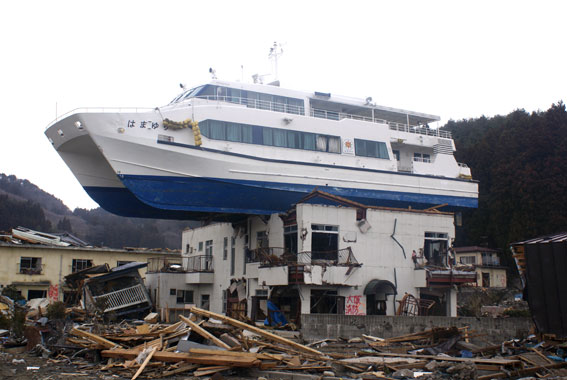 |
|
The second floor of a building deposited ontop of another building. The spraypaint on the side shows it was searched on the 17th March |
 |
